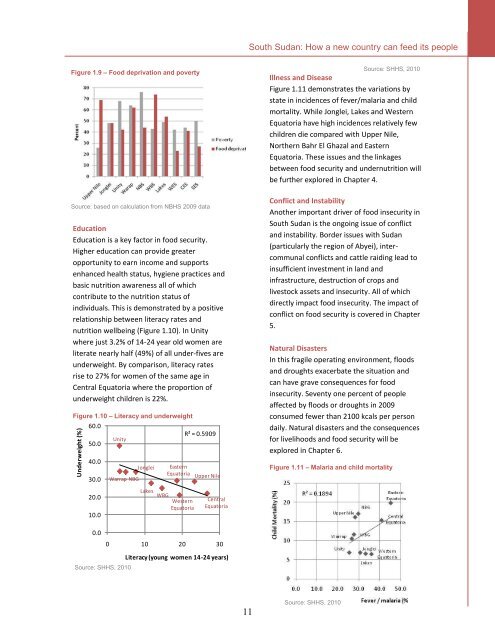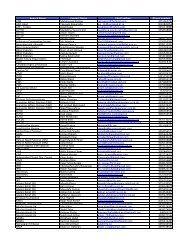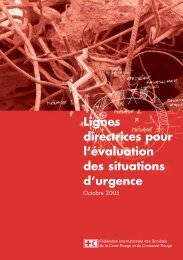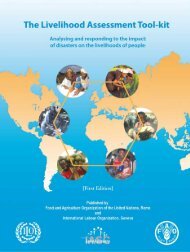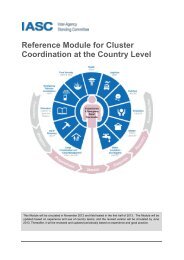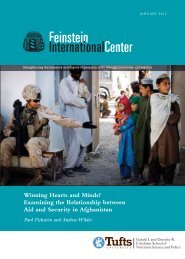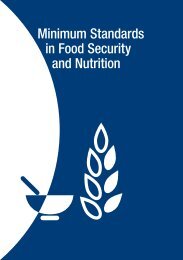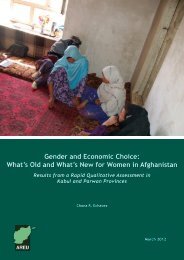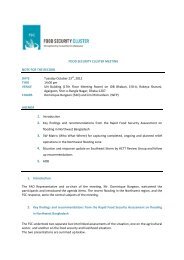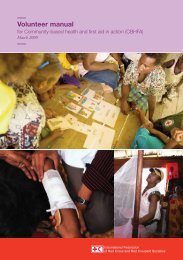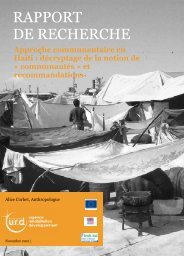4.15 MB - Food Security Clusters
4.15 MB - Food Security Clusters
4.15 MB - Food Security Clusters
- No tags were found...
Create successful ePaper yourself
Turn your PDF publications into a flip-book with our unique Google optimized e-Paper software.
Underweight (%)South Sudan: How a new country can feed its peopleFigure 1.9 – <strong>Food</strong> deprivation and povertySource: based on calculation from NBHS 2009 dataEducationEducation is a key factor in food security.Higher education can provide greateropportunity to earn income and supportsenhanced health status, hygiene practices andbasic nutrition awareness all of whichcontribute to the nutrition status ofindividuals. This is demonstrated by a positiverelationship between literacy rates andnutrition wellbeing (Figure 1.10). In Unitywhere just 3.2% of 14-24 year old women areliterate nearly half (49%) of all under-fives areunderweight. By comparison, literacy ratesrise to 27% for women of the same age inCentral Equatoria where the proportion ofunderweight children is 22%.Figure 1.10 – Literacy and underweight60.050.040.030.020.010.0UnityWarrap NBGJongleiEasternEquatoriaLakesWBGWesternEquatoriaR² = 0.5909Upper NileCentralEquatoriaSource: SHHS, 2010Illness and DiseaseFigure 1.11 demonstrates the variations bystate in incidences of fever/malaria and childmortality. While Jonglei, Lakes and WesternEquatoria have high incidences relatively fewchildren die compared with Upper Nile,Northern Bahr El Ghazal and EasternEquatoria. These issues and the linkagesbetween food security and undernutrition willbe further explored in Chapter 4.Conflict and InstabilityAnother important driver of food insecurity inSouth Sudan is the ongoing issue of conflictand instability. Border issues with Sudan(particularly the region of Abyei), intercommunalconflicts and cattle raiding lead toinsufficient investment in land andinfrastructure, destruction of crops andlivestock assets and insecurity. All of whichdirectly impact food insecurity. The impact ofconflict on food security is covered in Chapter5.Natural DisastersIn this fragile operating environment, floodsand droughts exacerbate the situation andcan have grave consequences for foodinsecurity. Seventy one percent of peopleaffected by floods or droughts in 2009consumed fewer than 2100 kcals per persondaily. Natural disasters and the consequencesfor livelihoods and food security will beexplored in Chapter 6.Figure 1.11 – Malaria and child mortality0.00 10 20 30Literacy (young women 14-24 years)Source: SHHS, 201011Source: SHHS, 2010


